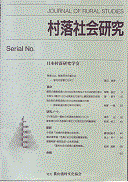8 巻, 2 号
選択された号の論文の8件中1~8を表示しています
- |<
- <
- 1
- >
- >|
論文
-
2002 年 8 巻 2 号 p. 1-11
発行日: 2002年
公開日: 2013/08/10
PDF形式でダウンロード (7696K) -
2002 年 8 巻 2 号 p. 12-23
発行日: 2002年
公開日: 2013/08/10
PDF形式でダウンロード (9124K) -
2002 年 8 巻 2 号 p. 24-35
発行日: 2002年
公開日: 2013/08/10
PDF形式でダウンロード (9397K)
フィールドノート
-
2002 年 8 巻 2 号 p. 36-53
発行日: 2002年
公開日: 2013/08/10
PDF形式でダウンロード (12194K)
書評
-
2002 年 8 巻 2 号 p. 54-55
発行日: 2002年
公開日: 2013/08/10
PDF形式でダウンロード (1898K) -
2002 年 8 巻 2 号 p. 56-57
発行日: 2002年
公開日: 2013/08/10
PDF形式でダウンロード (1772K) -
2002 年 8 巻 2 号 p. 58-59
発行日: 2002年
公開日: 2013/08/10
PDF形式でダウンロード (1767K) -
2002 年 8 巻 2 号 p. 60-61
発行日: 2002年
公開日: 2013/08/10
PDF形式でダウンロード (1859K)
- |<
- <
- 1
- >
- >|
